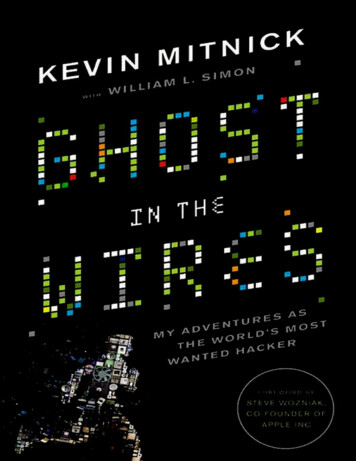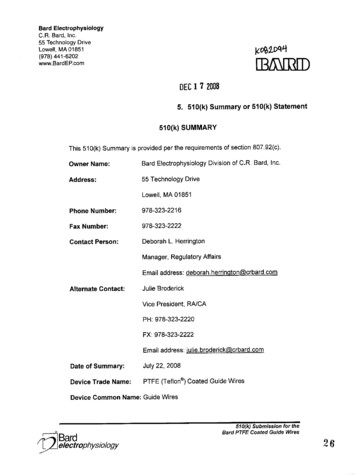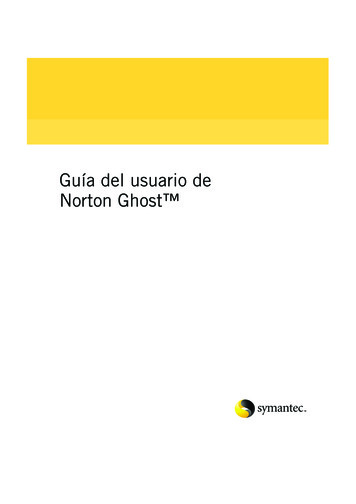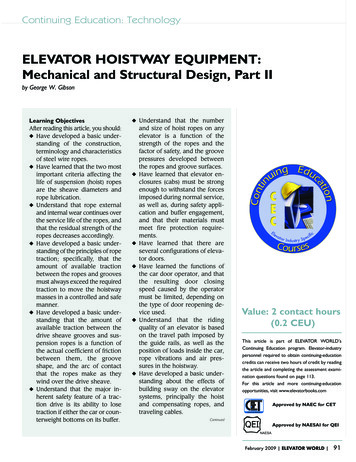
Transcription
LITTLE, BROWN AND C OMPANYNew York Boston London
Begin ReadingTable of ContentsPhoto InsertsCopyright Page
For my mother and grandmother—K.D.M.For Arynne, Victoria, and David,Sheldon, Vincent, and Elena Roseand especially for Charlotte—W.L.S.
FOREWORDI met Kevin Mitnick for the first time in 2001, during the filming of a Discovery Channel documentary called The History of Hacking, and we continued thecontact. Two years later, I flew to Pittsburgh to introduce him for a talk he was giving at Carnegie Mellon University, where I was dumbfounded to hear hishacking history. He broke into corporate computers but didn’t destroy files, and he didn’t use or sell credit card numbers he had access to. He tooksoftware but never sold any of it. He was hacking just for the fun of it, just for the challenge.In his speech, Kevin spelled out in detail the incredible story of how he had cracked the case of the FBI operation against him. Kevin penetrated thewhole operation, discovering that a new hacker “friend” was really an FBI snitch, learning the names and home addresses of the entire FBI team workinghis case, even listening in on the phone calls and voicemails of people trying to gather evidence against him. An alarm system he had set up alerted himwhen the FBI was preparing to raid him.When the producers of the TV show Screen Savers invited Kevin and me to host an episode, they asked me to demonstrate a new electronic devicethat was just then coming onto the consumer market: the GPS. I was supposed to drive around while they tracked my car. On the air, they displayed amap of the seemingly random route I had driven. It spelled out a message:FREE KEVINWe shared the microphones again in 2006, when Kevin was the stand-in host of Art Bell’s talk show Coast to Coast AM and invited me to join him ashis on-air guest. By then I had heard a lot of his story; that night he interviewed me about mine and we shared many laughs, as we usually do when we’retogether.My life has been changed by Kevin. One day I realized that I was getting his phone calls from faraway places: he was in Russia to give a speech, inSpain to help a company with security issues, in Chile to advise a bank that had had a computer break-in. It sounded pretty cool. I hadn’t used mypassport in about ten years until those phone calls gave me an itch. Kevin put me in touch with the agent who books his speeches. She told me, “I can getspeaking engagements for you, too.” So thanks to Kevin, I’ve become an international traveler like him.Kevin has become one of my best friends. I love being around him, hearing the stories about his exploits and adventures. He has lived a life asexciting and gripping as the best caper movies.Now you’ll be able to share all these stories that I have heard one by one, now and then through the years. In a way, I envy the experience of thejourney you’re about to start, as you absorb the incredible, almost unbelievable tale of Kevin Mitnick’s life and exploits.—Steve Wozniak,cofounder, Apple, Inc.
PROLOGUEPhysical entry”: slipping into a building of your target company. It’s something I never like to do. Way too risky. Just writing about it makes me practicallybreak out in a cold sweat.But there I was, lurking in the dark parking lot of a billion-dollar company on a warm evening in spring, watching for my opportunity. A week earlier Ihad paid a visit to this building in broad daylight, on the pretext of dropping off a letter to an employee. The real reason was so I could get a good look attheir ID cards. This company put the employee’s head shot upper left, name just below that, last name first, in block letters. The name of the company wasat the bottom of the card, in red, also in block letters.I had gone to Kinko’s and looked up the company’s website, so I could download and copy an image of the company logo. With that and a scannedcopy of my own photo, it took me about twenty minutes working in Photoshop to make up and print out a reasonable facsimile of a company ID card,which I sealed into a dime-store plastic holder. I crafted another phony ID for a friend who had agreed to go along with me in case I needed him.Here’s a news flash: it doesn’t even have to be all that authentic looking. Ninety-nine percent of the time, it won’t get more than a glance. As long asthe essential elements are in the right place and look more or less the way they are supposed to, you can get by with it unless, of course, someoverzealous guard or an employee who likes to play the role of security watchdog insists on taking a close look. It’s a danger you run when you live a lifelike mine.In the parking lot, I stay out of sight, watching the glow of cigarettes from the stream of people stepping out for a smoke break. Finally I spot a little pack offive or six people starting back into the building together. The rear entrance door is one of those that unlock when an employee holds his or her accesscard up to the card reader. As the group single-files through the door, I fall in at the back of the line. The guy ahead of me reaches the door, noticesthere’s someone behind him, takes a quick glance to make sure I’m wearing a company badge, and holds the door open for me. I nod a thanks.This technique is called “tailgating.”Inside, the first thing that catches my eye is a sign posted so you see it immediately as you walk in the door. It’s a security poster, warning not to holdthe door for any other person but to require that each person gain entrance by holding up his card to the reader. But common courtesy, everydaypoliteness to a “fellow employee,” means that the warning on the security poster is routinely ignored.Inside the building, I begin walking corridors with the stride of someone en route to an important task. In fact I’m on a voyage of exploration, looking forthe offices of the Information Technology (IT) Department, which after about ten minutes I find in an area on the western side of the building. I’ve done myhomework in advance and have the name of one of the company’s network engineers; I figure he’s likely to have full administrator rights to the company’snetwork.Damn! When I find his workspace, it’s not an easily accessible cubicle but a separate office behind a locked door. But I see a solution. The ceilingis made up of those white soundproofing squares, the kind often used to create a dropped ceiling with a crawl space above for piping, electrical lines, airvents, and so on.I cell-phone to my buddy that I need him, and make my way back to the rear entrance to let him in. Lanky and thin, he will, I hope, be able to do what Ican’t. Back in IT, he clambers onto a desk. I grab him around the legs and boost him up high enough that he’s able to raise one of the tiles and slide it outof the way. As I strain to raise him higher, he manages to get a grip on a pipe and pull himself up. Within a minute, I hear him drop down inside the lockedoffice. The doorknob turns and he stands there, covered in dust but grinning brightly.I enter and quietly close the door. We’re safer now, much less likely to be noticed. The office is dark. Turning on a light would be dangerous but it isn’tnecessary—the glow from the engineer’s computer is enough for me to see everything I need, reducing the risk. I take a quick scan of his desk and checkthe top drawer and under the keyboard to see if he has left himself a note with his computer password. No luck. But not a problem.From my fanny pack, I pull out a CD with a bootable version of the Linux operating system that contains a hacker toolkit and pop it into his CD drive,then restart the computer. One of the tools allows me to change the local administrator’s password on his computer; I change it to something I know, so Ican log in. I then remove my CD and again restart the computer, this time logging in to the local administrator account.Working as fast as I can, I install a “remote access Trojan,” a type of malicious software that gives me full access to the system, so I can logkeystrokes, grab password hashes, and even instruct the webcam to take pictures of the person using the computer. The particular Trojan I’ve installedwill initiate an Internet connection to another system under my control every few minutes, enabling me to gain full control of the victim’s system.Almost finished, as a last step I go into the registry of his computer and set “last logged-in user” to the engineer’s username so there won’t be anyevidence of my entry into the local administrator account. In the morning, the engineer may notice that he’s logged out. No problem: as soon as he logsback in, everything will look just as it should.I’m ready to leave. By now my buddy has replaced the overhead tiles. On the way out, I reset the lock.The next morning, the engineer turns on his computer at about 8:30 a.m., and it establishes a connection to my laptop. Because the Trojan is runningunder his account, I have full domain administrator privileges, and it takes me only a few seconds to identify the domain controller that contains all theaccount passwords for the entire company. A hacker tool called “fgdump” allows me to dump the hashed (meaning scrambled) passwords for every user.Within a few hours, I have run the list of hashes through “rainbow tables”—a huge database of precomputed password hashes—recovering thepasswords of most of the company’s employees. I eventually find one of the back-end computer servers that process customer transactions but discoverthe credit card numbers are encrypted. Not a problem: I find the key used to encrypt the card numbers is conveniently hidden in a stored procedure withinthe database on a computer known as the “SQL server,” accessible to any database administrator.Millions and millions of credit card numbers. I can make purchases all day long using a different credit card each time, and never run out of numbers.But I made no purchases. This true story is not a new replay of the hacking that landed me in a lot of hot water. Instead it was something I was hired to do.It’s what we call a “pen test,” short for “penetration test,” and it’s a large part of what my life consists of these days. I have hacked into some of thelargest companies on the planet and penetrated the most resilient computer systems ever developed—hired by the companies themselves, to help themclose the gaps and improve their security so they don’t become the next hacking victim. I’m largely self-taught and have spent years studying methods,tactics, and strategies used to circumvent computer security, and to learn more about how computer systems and telecommunication systems work.My passion for technology and fascination with it have taken me down a bumpy road. My hacking escapades ended up costing me over five years ofmy life in prison and causing my loved ones tremendous heartache.Here is my story, every detail as accurate as I can make it from memory, personal notes, public court records, documents obtained through theFreedom of Information Act, FBI wiretap and body-wire recordings, many hours of interviews, and discussions with two government informants.This is the story of how I became the world’s most wanted computer hacker.
PART ONE
The Making of a Hacker
ONE
Rough StartYjcv ku vjg pcog qh vjg uauvgo wugf da jco qrgtcvqtuvq ocmg htgg rjqpg ecnnu?M y instinct for finding a way around barriers and safeguards began very early. At about age one and a half, I found a way to climb out of my crib, crawl tothe child gate at the door, and figure out how to open it. For my mom, it was the first wake-up call for all that was to follow.I grew up as an only child. After my dad left when I was three, my mother, Shelly, and I lived in nice, medium-priced apartments in safe areas of theSan Fernando Valley, just over the hill from the city of Los Angeles. My mom supported us with waitressing jobs in one or another of the many delis strungout along Ventura Boulevard, which runs east–west for the length of the valley. My father lived out of state and, though he cared about me, was for themost part only occasionally involved in my life growing up until he moved to Los Angeles when I was thirteen years old.Mom and I moved so often I didn’t have the same chance to make friends as other kids did. I spent my childhood largely involved in solitary, mostlysedentary pursuits. When I was at school, the teachers told my mom that I was in the top 1 percentile in mathematics and spelling, years ahead of mygrade. But because I was hyperactive as a child, it was hard for me to sit still.Mom had three husbands and several boyfriends when I was growing up. One abused me, another—who worked in law enforcement—molested me.Unlike some other moms I’ve read about, she never turned a blind eye. From the moment she found out I was being mistreated—or even spoken to in arough way—the guy was out the door for good. Not that I’m looking for excuses, but I wonder if those abusive men had anything to do with my growing upto a life of defying authority figures.Summers were the best, especially if my mom was working a split shift and had time off in the middle of the day. I loved it when she’d take meswimming at the amazing Santa Monica Beach. She’d lie on the sand, sunning and relaxing, watching me splashing in the waves, getting knocked downand coming up laughing, practicing the swimming I had learned at a YMCA camp that I went to for several summers (and always hated except when theytook us all to the beach).I was good at sports as a kid, happy playing Little League, serious enough to enjoy spending spare time at the batting cage. But the passion that setme on a life course began when I was ten. A neighbor who lived in the apartment across from us had a daughter about my age whom I guess I developeda crush on, which she reciprocated by actually dancing naked in front of me. At that age, I was more interested in what her father brought into my life:magic.He was an accomplished magician whose card tricks, coin tricks, and larger effects fascinated me. But there was something else, something moreimportant: I saw how his audiences of one, three, or a roomful found delight in being deceived. Though this was never a conscious thought, the notion thatpeople enjoyed being taken in was a stunning revelation that influenced the course of my life.A magic store just a short bike ride away became my spare-time hangout. Magic was my original doorway into the art of deceiving people.Sometimes instead of riding my bike I’d hop on the bus. One day a couple of years later a bus driver named Bob Arkow noticed I was wearing a Tshirt that said, “CBers Do It on the Air.” He told me he’d just found a Motorola handheld that was a police radio. I thought maybe he could listen in on thepolice frequencies, which would be very cool. It turned out he was pulling my leg about that, but Bob was an avid ham radio operator, and his enthusiasmfor the hobby sparked my interest. He showed me a way to make free telephone calls over the radio, through a service called an “auto patch” provided bysome of the hams. Free phone calls! That impressed me no end. I was hooked.After several weeks of sitting in a nighttime classroom, I had learned enough about radio circuits and ham radio regulations to pass the written exam,and mastered enough Morse code to meet that qualification as well. Soon the mailman brought an envelope from the Federal CommunicationsCommission with my ham radio license, something not many kids in their early teens have ever had. I felt a huge sense of accomplishment.Fooling people with magic was cool. But learning how the phone system worked was fascinating. I wanted to learn everything about how the phonecompany worked. I wanted to master its inner workings. I had been getting very good grades all the way through elementary school and in junior high, butaround eighth or ninth grade I started cutting classes to hang out at Henry Radio, a ham radio store in West Los Angeles, reading books for hours onradio theory. To me, it was as good as a visit to Disneyland. Ham radio also offered some opportunities for helping out in the community. For a time Iworked as a volunteer on occasional weekends to provide communications support for the local Red Cross chapter. One summer I spent a week doingthe same for the Special Olympics.Riding the buses was for me a bit like being on holiday—taking in the sights of the city, even when they were familiar ones. This was Southern California,so the weather was almost always near perfect, except when the smog settled in—much worse in those times than today. The bus cost twenty-five cents,plus ten cents for a transfer. On summer vacation when my mom was at work, I’d sometimes ride the bus all day. By the time I was twelve, my mind wasalready running in devious channels. One day it occurred to me, If I could punch my own transfers, the bus rides wouldn’t cost anything.My father and my uncles were all salesmen with the gift of gab. I guess I share the gene that gave me my ability from very early on to talk people intodoing things for me. I walked to the front of the bus and sat down in the closest seat to the driver. When he stopped at a light, I said, “I’m working on aschool project and I need to punch interesting shapes on pieces of cardboard. The punch you use on the transfers would be great for me. Is theresomeplace I can buy one?”I didn’t think he’d believe it because it sounded so stupid. I guess the idea never crossed his mind that a kid my age might be manipulating him. Hetold me the name of the store, and I called and found out they sold the punches for 15. When you were twelve, could you come up with a reasonableexcuse you might have given your mother about why you needed 15? I had no trouble. The very next day I was in the store buying a punch. But that wasonly Step One. How was I going to get books of blank transfers?Well, where did the buses get washed? I walked over to the nearby bus depot, spotted a big Dumpster in the area where the buses were cleaned,pulled myself up, and looked in.Jackpot!I stuffed my pockets with partially used books of transfers—my first of what would be many, many acts of what came to be called “Dumpster-diving.”My memory has always been way better than average and I managed to memorize the bus schedules for most of the San Fernando Valley. I started toroam by bus everywhere the bus system covered—Los Angeles County, Riverside County, San Bernardino County. I enjoyed seeing all those differentplaces, taking in the world around me.In my travels, I made friends with a kid named Richard Williams, who was doing the same thing, but with two pretty major differences. For one thing, hisfree-roaming travels were legal because, as the son of a bus driver, Richard rode for free. The second aspect that separated us (initially, anyway) was our
difference in weight: Richard was obese and wanted to stop at Jack in the Box for a Super Taco five or six times a day. Almost at once I adopted hiseating habits and began growing around the middle.It wasn’t long before a pigtailed blond girl on the school bus told me, “You’re kinda cute, but you’re fat. You oughta lose some weight.”Did I take her sharp but unquestionably constructive advice to heart? Nope.Did I get into trouble for Dumpster-diving for those bus transfers and riding for free? Again, no. My mom thought it was clever, my dad thought itshowed initiative, and bus drivers who knew I was punching my own transfers thought it was a big laugh. It was as though everyone who knew what I wasup to was giving me attaboys.In fact, I didn’t need other people’s praise for my misdeeds to lead me into more trouble. Who would have thought that a little shopping trip couldprovide a lesson that would set my life on a new course in an unfortunate direction?
TWO
Just VisitingWbth lal voe htat oy voe wxbirtn vfzbqt wagye C poh aeovsn vojgav?Even many Jewish families that aren’t very religious want their sons to have a bar mitzvah, and I fell into that category. This includes standing up in frontof the congregation and reading a passage from the Torah scroll—in Hebrew. Of course, Hebrew uses a completely different alphabet, with , , , andthe like, so mastering the Torah portion can take months of study.I was signed up at a Hebrew school in Sherman Oaks but got booted for goofing off. Mom found a cantor to teach me one-on-one, so I couldn’t getaway with reading a technology book under the table. I managed to learn enough to get through the service and read my Torah passage aloud to thecongregation with no more than the usual amount of stumbling, and without embarrassing myself.Afterward my parents chided me for mimicking the accent and gestures of the rabbi. But it was subconscious. I’d later learn that this is a very effectivetechnique because people are attracted to others who are like themselves. So at a very early age, all unaware, I was already practicing what would cometo be called “social engineering”—the casual or calculated manipulation of people to influence them to do things they would not ordinarily do. Andconvincing them without raising the least hint of suspicion.The typical shower of presents from relatives and from people who attended the reception after the bar mitzvah at the Odyssey Restaurant left me withgifts that included a number of U.S. Treasury bonds that came to a surprisingly handsome sum.I was an avid reader, with a particular focus that led me to a place called the Survival Bookstore in North Hollywood. It was small and in a seedyneighborhood and was run by a middle-aged, friendly blond lady who said I could call her by her first name. The place was like finding a pirate’s treasurechest. My idols in those days were Bruce Lee, Houdini, and Jim Rockford, the cool private detective played by James Garner in The Rockford Files, whocould pick locks, manipulate people, and assume a false identity in a matter of moments. I wanted to be able to do all the neat things Rockford could.The Survival Bookstore carried books describing how to do all those nifty Rockford things, and lots more besides. Starting at age thirteen, I spentmany of my weekends there, all day long, studying one book after another—books like The Paper Trip by Barry Reid, on how to create a new identity byusing a birth certificate of someone who had passed away.A book called The Big Brother Game, by Scott French, became my Bible because it was crammed with details on how to get hold of driving records,property records, credit reports, banking information, unlisted numbers, and even how to get information from police departments. (Much later, whenFrench was writing a follow-up volume, he called to ask me if I would do a chapter on techniques for social-engineering the phone companies. At the time,my coauthor and I were writing our second book, The Art of Intrusion, and I was too busy for French’s project, though amused by the coincidence, andflattered to be asked.)That bookstore was crammed with “underground” books that taught you things you weren’t supposed to know—very appealing to me since I hadalways had this urge to take a bite of knowledge from the forbidden apple. I was soaking up the knowledge that would turn out to be invaluable almost twodecades later, when I was on the run.The other item that interested me at the store besides their books was the lockpicking tools they offered for sale. I bought several different kinds.Remember the old joke that goes, “How do you get to Carnegie Hall? Practice, practice, practice”? That’s what I did to master the art of lockpicking,sometimes going down to the area of tenant storage lockers in the garage of our apartment building, where I’d pick open some of the padlocks, swapthem around, and lock them again. At the time I thought it was an amusing practical joke, though looking back, I’m sure it probably threw some people intoangry fits and put them to a good deal of trouble, plus the expense of a new lock after they had managed to get the old one removed. Only funny, I guess,when you’re a teenager.One day when I was about fourteen, I was out with my uncle Mitchell, who was a bright star of my life in those years. We swung by the Department ofMotor Vehicles and found it packed with people. He left me to wait while he walked straight up to the counter—just like that, walking past everyonestanding in line. The DMV clerk, a lady with a bored expression, looked up in surprise. He didn’t wait for her to finish what she was doing with the man atthe window but just started talking. He hadn’t said more than a few words when the clerk nodded to him, signaled the other man to step aside, and tookcare of whatever it was Uncle Mitchell wanted. My uncle had some special talent with people.And I appeared to have it, too. It was my first conscious example of social engineering.How did people see me at Monroe High School? My teachers would have said that I was always doing unexpected things. When the other kids werefixing televisions in TV repair shop, I was following in Steve Jobs and Steve Wozniak’s footsteps and building a blue box that would allow me tomanipulate the phone network and even make free phone calls. I always brought my handheld ham radio to school and talked on it during lunch andrecess.But one fellow student changed the course of my life. Steven Shalita was an arrogant guy who fancied himself as an undercover cop—his car wascovered with radio antennas. He liked to show off the tricks he could do with the telephone, and he could do some amazing things. He demonstrated howhe could have people call him without revealing his real phone number by using a phone company test circuit called a “loop-around”; he would call in onone of the loop’s phone numbers while the other person was calling the loop’s second phone number. The two callers would be magically connected. Hecould get the name and address assigned to any phone number, listed or not, by calling the phone company’s Customer Name and Address (CNA)Bureau. With a single call, he got my mom’s unlisted phone number. Wow! He could get the phone number and address of anyone, even a movie star withan unlisted number. It seemed like the folks at the phone company were just standing by to see what they could do to help him.I was fascinated, intrigued, and I instantly became his companion, eager to learn all those incredible tricks. But Steven was only interested in showingme what he could do, not in telling me how all of this worked, how he was able to use his social-engineering skills on the people he was talking to.Before long I had picked up just about everything he was willing to share with me about “phone phreaking” and was spending most of my free timeexploring the telecommunications networks and learning on my own, figuring out things Steven didn’t even know about. And “phreakers” had a socialnetwork. I started getting to know others who shared similar interests and going to their get-togethers, even though some of the “phreaks” were, well,freaky—socially inept and uncool.I seemed cut out for the social-engineering part of phreaking. Could I convince a phone company technician to drive to a “CO” (a central office—theneighborhood switching center that routes calls to and from a telephone) in the middle of the night to connect a “critical” circuit because he thought I wasfrom another CO, or maybe a lineman in the field? Easy. I already knew I had talents along these lines, but it was my high school associate Steven whotaught me just how powerful that ability could be.The basic tactic is simple. Before you start social engineering for some particular goal, you do your reconnaissance. You piece together information
about the company, including how that department or business unit operates, what its function is, what information the employees have access to, thestandard procedure for making requests, whom they routinely get requests from, under what conditions they release the desired information, and the lingoand terminology used in the company.The social-engineering techniques work simply because people are very trusting of anyone who establishes credibility, such as an authorizedemployee of the company. That’s where the research comes in. When I was ready to get access to nonpublished numbers, I called one of the phonecompany’s business office representatives and said, “This is Jake Roberts, from the Non-Pub Bureau. I need to talk to a supervisor.”When the supervisor came on the line, I introduced myself again and said, “Did you get our memo that we’re changing our number?”She went to check, came back on the line, and said, “No, we didn’t.”I said, “You should be using 213 687-9962.”“No,” she said. “We dial 213 320-0055.”Bingo!“Okay,” I told her. “We’ll be sending a memo to a second-level”—the phone company lingo for a manager—“regarding the change. Meanwhile keepon using 320-0055 until you get the memo.”But when I called the Non-Pub Bureau, it turned out my name had to be on a list of authorized people, with an internal callback number, before theywould release any customer information to me. A novice or inept social engineer might have just hung up. Bad news: it raises suspicions.Ad-libbing on the spot, I said, “My manager told me he was putting me on the list. I’ll have to tell him you didn’t get his memo yet.”Another hurdle: I would somehow have to be able to provide a phone number internal to the phone company that I could receive calls on!I had to call three different business offices before I found one that had a second-level who was a man—someone I could impersonate. I told him,“This is Tom Hansen from the Non-Pub Bureau. We’re updating our list of authorized employees. Do you still need to be on the list?”Of course he said yes.I then asked him to spell his name and give me his phone number. Like taking candy from a baby.My next call was to RCMAC—the Recent Change Memory Authorization Center, t
Kevin has become one of my best friends. I love being around him, hearing the stories about his exploits and adventures. He has lived a life as exciting and gripping as the best caper movies. Now you’ll be able to share all these stories that I have heard one by one, now and then











